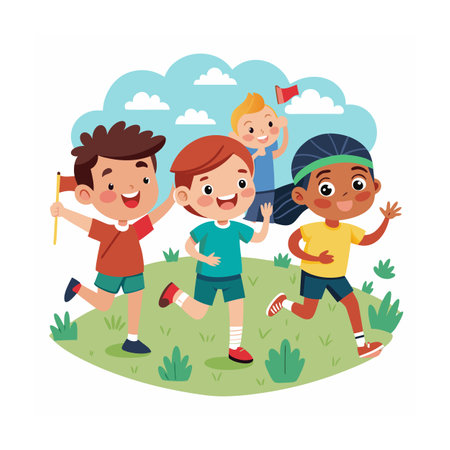What Is Pediatric Rehabilitation?
Pediatric rehabilitation is a specialized area of healthcare focused on helping children with physical, developmental, or cognitive challenges reach their full potential. Unlike adult rehabilitation, pediatric rehab centers around the unique needs and growth patterns of kids, from infants to teenagers. It involves a team approach—combining medical professionals, therapists, and families—to support children as they develop important life skills.
The Core Principles of Pediatric Rehabilitation
Pediatric rehabilitation is guided by several key principles that make it effective for growing children:
| Principle | Description |
|---|---|
| Family-Centered Care | Families play an active role in setting goals and participating in therapy sessions. |
| Individualized Plans | Treatment is tailored to each child’s unique strengths, challenges, and interests. |
| Developmental Focus | Therapies match the child’s current stage of growth and promote age-appropriate milestones. |
| Interdisciplinary Teamwork | Medical providers, physical therapists, occupational therapists, speech therapists, and psychologists work together. |
| Positive Reinforcement | Celebrating small achievements encourages progress and builds confidence. |
Why Early Intervention Matters
The earlier a child receives support through pediatric rehabilitation, the better the outcomes. Early intervention can:
- Help children develop crucial motor, language, and social skills during key growth periods.
- Prevent secondary complications (like muscle tightness or joint issues).
- Improve independence in daily activities like dressing, eating, or communicating.
- Boost self-esteem by fostering success at an early age.
- Support families with education and resources for home care.
Common Reasons Children Need Pediatric Rehab
| Condition/Challenge | How Pediatric Rehab Helps |
|---|---|
| Cerebral Palsy | Improves movement, strength, and coordination; teaches adaptive skills. |
| Developmental Delays | Addresses delays in walking, talking, or self-care tasks through targeted therapies. |
| Autism Spectrum Disorder (ASD) | Supports communication, social interaction, and daily routines. |
| Brain Injuries or Illnesses | Aids recovery and helps relearn lost skills. |
| Orthopedic Conditions (e.g., fractures) | Aids healing and restores function after injury or surgery. |
Pediatric Rehab: A Support System for Families
Pediatric rehabilitation isn’t just about therapy sessions—it’s about building a supportive environment where children can thrive. By working closely with therapists and educators, families can learn strategies to encourage progress at home and in the community. This collaborative approach gives every child the best chance to succeed as they grow and explore the world around them.
2. Common Conditions and When to Seek Help
When your child is facing developmental or physical challenges, knowing what to look out for and when to seek professional help can be overwhelming. Pediatric rehabilitation covers a wide range of conditions that affect children’s growth, movement, communication, and daily activities. Understanding the most common diagnoses and their early signs can make a big difference in your childs health journey.
Typical Pediatric Diagnoses That Benefit from Rehabilitation
| Condition | Brief Description | Possible Signs |
|---|---|---|
| Cerebral Palsy (CP) | A group of disorders affecting movement and muscle tone due to brain injury or abnormal development. | Stiff or floppy muscles, delays in reaching motor milestones, trouble with coordination. |
| Autism Spectrum Disorder (ASD) | A developmental disorder affecting communication, behavior, and social skills. | Lack of eye contact, delayed speech, repetitive movements, difficulty with social interaction. |
| Down Syndrome | A genetic condition causing intellectual disability and physical challenges. | Delayed milestones, low muscle tone, distinctive facial features. |
| Spina Bifida | A birth defect where the spine doesn’t form properly. | Weakness or paralysis in legs, bladder/bowel issues, orthopedic problems. |
| Muscular Dystrophy | A group of diseases causing progressive muscle weakness. | Trouble walking or climbing stairs, frequent falls, muscle pain or stiffness. |
| Torticollis | A condition where neck muscles cause the head to tilt to one side. | Head tilting to one side, difficulty turning head equally both ways. |
| Developmental Delay | When a child doesn’t reach milestones at the expected times. | Sitting, standing, or walking later than peers; trouble with speech or understanding language. |
Recognizing Signs That Your Child May Need Rehab Services
- Motor Delays: Not rolling over, sitting up, crawling, or walking at the usual ages.
- Trouble with Coordination: Clumsiness beyond what’s typical for their age; frequent falls.
- Poor Muscle Tone: Either very stiff or unusually floppy muscles.
- Speech Delays: Not babbling by 12 months or not speaking simple words by 18 months.
- Difficulties with Daily Activities: Trouble using hands for play, eating, or dressing themselves.
- Pain or Discomfort: Complaints of pain during movement or reluctance to participate in physical activities.
- Behavioral Concerns: Difficulty interacting with others or showing repetitive behaviors that interfere with learning and play.
When Should Parents Consult a Specialist?
If you notice any of the above signs or have concerns about your childs development—even if they seem minor—it’s always best to discuss them with your pediatrician. Early intervention is key. Your doctor can guide you toward pediatric rehabilitation services such as physical therapy (PT), occupational therapy (OT), or speech-language therapy (SLP). Don’t wait for issues to “resolve on their own”—getting help early can set your child up for long-term success and independence.

3. The Pediatric Rehab Team: Who’s Involved?
When your child begins pediatric rehabilitation, you’ll meet a dedicated team of specialists who work together to support your child’s growth and development. This collaborative approach is called an interdisciplinary team, and each member brings unique skills to help your child reach their fullest potential. Here’s a breakdown of the main professionals you might encounter and how they work together with families.
Key Members of the Pediatric Rehab Team
| Team Member | What They Do | How They Help Your Child |
|---|---|---|
| Physical Therapist (PT) | Focuses on movement, balance, strength, and coordination | Helps improve walking, posture, flexibility, and motor skills |
| Occupational Therapist (OT) | Works on daily living skills like dressing, feeding, and writing | Supports independence in everyday tasks at home and school |
| Speech-Language Pathologist (SLP) | Assists with speech, language, communication, and swallowing issues | Helps your child communicate better and eat safely |
| Pediatrician/Physiatrist | Medical doctors specializing in child development or rehab medicine | Oversees overall health and coordinates care plans |
| Social Worker/Case Manager | Offers support for family needs and connects you to resources | Makes sure you have what you need throughout the rehab journey |
| Psychologist/Counselor | Focuses on emotional well-being and coping strategies | Helps children and families manage stress or behavioral challenges |
The Power of Teamwork: How Collaboration Works
The pediatric rehab team doesn’t just work with your child—they also work closely with you as parents or caregivers. Here’s how collaboration happens:
- Regular Meetings: The team meets to discuss your child’s progress and update goals as needed.
- Personalized Plans: Therapists design individualized programs tailored to your child’s strengths and needs.
- Family Involvement: Families are encouraged to take part in therapy sessions, ask questions, and practice activities at home.
- Open Communication: Team members share updates with each other—and with you—so everyone stays on the same page.
- Cultural Sensitivity: Providers respect family traditions, values, and preferences while building care plans.
Your Role as Part of the Team
You are a key partner in this process! By sharing insights about your child’s routines, interests, and goals, you help the team create meaningful strategies that fit into your daily life. Never hesitate to speak up—you know your child best!
A Real-Life Example:
If your child is working on learning to feed themselves, the OT might suggest adaptive utensils while the SLP helps with swallowing safety. The PT could show exercises for trunk control to make sitting at the table easier. Meanwhile, you practice these strategies at home—making everyday moments part of therapy.
This teamwork ensures that everyone is working toward the same goal: helping your child thrive at home, in school, and out in the community.
4. Therapies and Approaches Used in the U.S.
When it comes to pediatric rehabilitation in the United States, there are several evidence-based therapies and approaches that help children reach their fullest potential. These methods are designed to be child-friendly and fit into everyday life, making them easier for families to support at home and school. Below, you’ll find descriptions of some common therapies and strategies used across the country.
Play-Based Interventions
Play is a natural way for children to learn and grow. In pediatric rehab, therapists often use play-based interventions because kids are more engaged when activities feel like games rather than exercises. These sessions might include toys, puzzles, or outdoor activities that build strength, coordination, language, or social skills. Play therapy can be tailored for different developmental stages and abilities, ensuring each child gets what they need while having fun.
Adaptive Equipment
Sometimes, children need a little extra help to participate in daily activities. Adaptive equipment refers to tools and devices that make tasks easier or safer for kids with physical or developmental challenges. This can include things like:
| Type of Equipment | Purpose |
|---|---|
| Wheelchairs or Walkers | Helps with mobility inside and outside the home |
| Communication Devices | Supports speech or language development for non-verbal children |
| Specialized Utensils | Makes eating more manageable for children with fine motor difficulties |
| Sensory Tools | Reduces anxiety or improves focus by meeting sensory needs |
Therapists work closely with families to choose the right equipment, teach safe use, and adjust as children grow.
Collaboration with Schools
Pediatric rehabilitation doesn’t just happen in clinics—it extends into schools too. In the U.S., therapists often team up with teachers, special educators, and school counselors to create Individualized Education Programs (IEPs) or 504 Plans. These plans outline specific supports each child needs during the school day, such as:
- Extra time for tests or assignments
- Physical therapy breaks between classes
- Sensory-friendly classroom setups
- Speech therapy provided at school
This teamwork helps ensure children get consistent support no matter where they are.
Family-Centered Care
An important part of pediatric rehabilitation in America is involving families every step of the way. Parents are encouraged to join therapy sessions, ask questions, and practice new skills at home. Many clinics also offer parent training or support groups so families don’t feel alone on their journey.
Summary Table: Common Pediatric Rehab Approaches in the U.S.
| Approach | Main Goal | Example Activities/Tools |
|---|---|---|
| Play-Based Therapy | Build developmental skills through play | Puzzles, building blocks, pretend play games |
| Adaptive Equipment Use | Increase independence in daily activities | Wheelchairs, communication boards, weighted vests |
| School Collaboration | Create inclusive learning environments | IEPs, therapy breaks, classroom accommodations |
| Family Involvement | Empower parents as partners in care | Home exercise programs, parent workshops, support groups |
Pediatric rehab in the U.S. combines these evidence-based strategies to help every child thrive both at home and in their community.
5. How Parents Can Advocate and Support Their Child
Practical Tips for Supporting Your Child at Home
Supporting your child’s rehabilitation journey starts at home. Here are some practical tips:
- Create a Routine: Children thrive on consistency. Set regular times for therapy exercises, meals, play, and rest.
- Make Therapy Fun: Use games, songs, or favorite toys to turn exercises into enjoyable activities.
- Encourage Independence: Let your child try tasks on their own before stepping in to help. Praise their efforts to build confidence.
- Communicate Openly: Talk with your child about their feelings and progress. Listen to their concerns and celebrate achievements together.
Sample Home Support Schedule
| Time | Activity | Tips |
|---|---|---|
| 7:00 AM | Morning stretches | Play upbeat music |
| 12:00 PM | Lunchtime self-feeding practice | Use adaptive utensils if needed |
| 3:00 PM | Therapy exercises | Turn it into a game or challenge |
| 6:30 PM | Storytime & communication skills | Ask questions about the story |
Navigating Insurance and the Healthcare System
The U.S. healthcare system can feel overwhelming, but understanding your options helps ensure your child receives the best care possible.
- Know Your Coverage: Review your health insurance policy to understand which therapies are covered and if you need referrals or pre-authorization.
- Keep Records: Save all medical reports, therapy notes, and correspondence with insurance companies for easy reference.
- Ask Questions: Don’t hesitate to contact your insurance provider or social worker with questions about coverage or claims.
- Utilize Community Resources: Many states offer early intervention programs or Medicaid waivers for children with special needs.
Common U.S. Resources for Pediatric Rehabilitation Support
| Resource Name | Description | How to Access |
|---|---|---|
| Early Intervention (EI) | Services for children under 3 with developmental delays or disabilities | Your state’s Department of Health website or pediatrician referral |
| Shriners Hospitals for Children | No-cost specialty care for pediatric conditions like orthopedic issues and burns | Shriners website or doctor referral; no insurance required |
| Pediatric Therapy Clinics (Private/Outpatient) | Pediatric physical, occupational, and speech therapy services covered by most insurance plans | Pediatrician referral or direct contact with clinic; check insurance coverage first |
| The Arc / Family Voices / Parent Training Centers (PTI) | Advocacy, resources, and support groups for families of children with disabilities | Their official websites; local chapters often available nationwide |
Partnering With Educators and Schools
- Share Information: Keep teachers updated on your child’s rehab plan and needs. Provide copies of any Individualized Education Program (IEP) or therapy goals.
- Attend Meetings: Participate in IEP meetings and parent-teacher conferences. Bring questions or concerns about accommodations and progress.
- Create a Communication Plan: Decide how you’ll stay in touch—by email, notebook, or school app—to track daily updates and any challenges.
- Celebrate Progress Together: Share successes from home and school to encourage your child and maintain teamwork with educators.
Main Points of Contact at School for Rehab Support
| Role | Main Responsibilities | How They Help |
|---|---|---|
| Special Education Teacher | Carries out IEP goals and adapts lessons | Makes sure therapy strategies are used in class |
| Counselor/Social Worker | Adds emotional/behavioral support | Aids communication between family, teachers, and therapists |
| Therapists (PT/OT/ST) | Treats motor, sensory, or speech needs during school hours | Keeps parents informed on progress; suggests home activities |
| Mainstream Teacher | Sends updates on academic/social growth | Makes classroom adjustments as needed |
Your role as an advocate is essential—ask questions, seek resources, and remember that you know your child best. By working closely with healthcare providers, educators, and community organizations, you help ensure your child gets the support they need both at home and beyond.


